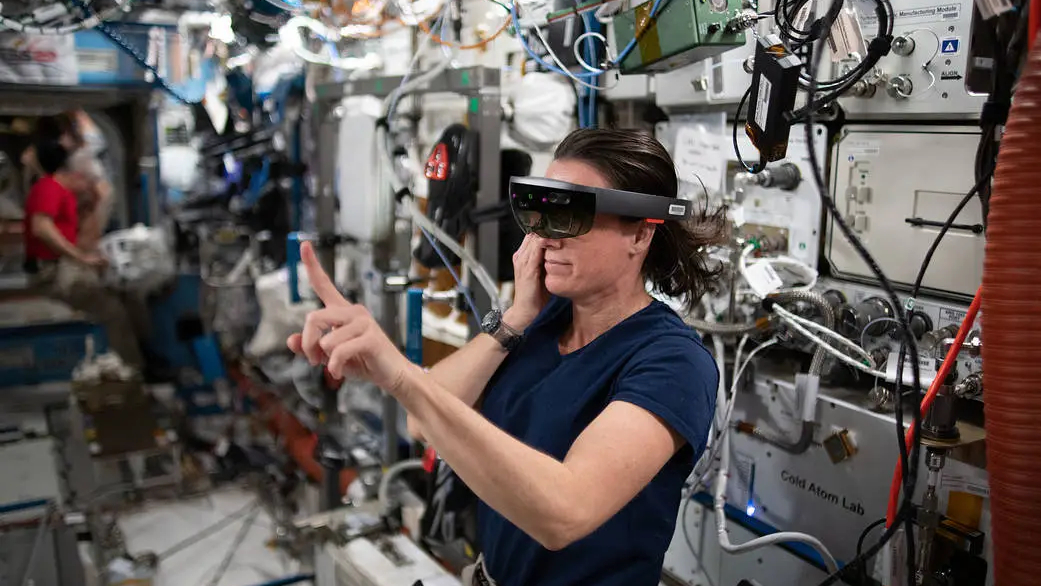Why a VR headset on the ISS 'really makes a difference' for astronaut exercise

Astronauts can now get a bit of simulated fresh air while working out in space.
A virtual reality (VR) headset paired with a new exercise bike lets International Space Station (ISS) astronauts experience their favorite cycling routes on Earth. Denmark's Andreas Mogensen, for example, has five routes to choose from in locations ranging from Copenhagen to Svanninge Bakker.
"It's actually one of my absolute favorite activities on board the space station," said Mogensen, commander of the ISS' current Expedition 70 and a European Space Agency (ESA) astronaut, told Space.com during a Wednesday (Feb. 21) press conference from the ISS about science experiments.
"It really makes a difference," Mogensen added. "There's something about when you see yourself biking up a hill, in the virtual reality headset, you just have more motivation to pedal a little bit harder."
Related: A VR headset that could help astronaut mental health is launching to ISS on SpaceX rocket
The HTC VIVE Focus 3 adds to a growing set of VR gear on the ISS aiming to help astronauts maintain their mental health in space, where crowded conditions, separation from friends and family and an intense schedule can contribute to feelings of loneliness.
"I absolutely love it. It also connects me with nature," Mogensen added of the VR exercise gear. "I feel like I'm out in the countryside biking, and it's just wonderful. It really is. We live on board the space station, which is a very synthetic environment. We can't go outside. We're not in contact with nature. This is as close as it gets. I use it every single time I exercise on the bike."
Breaking space news, the latest updates on rocket launches, skywatching events and more!
Astronauts have plenty of gear for exercise on the ISS, including a weightlifting machine and a treadmill. The exercise bike is called CEVIS, or Cycle Ergometer with Vibration Isolation and Stabilization. The first-generation CEVIS, installed in 2001, was used by 170 astronauts in its first 20 years of service alone, according to maker Danish Aerospace.
While CEVIS helped keep astronauts fit, there were limitations. It faced experiments in the busy U.S. Destiny laboratory, for instance, making it difficult to focus. The bike also maxed out at 350 watts of power during exercise, meaning that astronauts who wanted a more intense workout had few options.
A smaller, lighter and more powerful 500-watt unit known as Teal CEVIS was installed on the ISS on Oct. 24, 2023 after a previous installation try that month ran into "volume issues", according to NASA's ISS blog. The newer cycle also connects with the VIVE Focus 3, which has special sensors allowing the headset to work in the absence of gravity (lessening the seasickness you could feel with older VR systems).
The headset allows Mogensen "to combat the sterile and bland interior of the ISS, as well as the the constant hum of machines," VIVE officials wrote in a recent statement. "As he cycles, the scenery moves in time, and the VIVE Focus 3 sends information via Bluetooth to (the bike), which provides resistance as he cycles uphill or on different surfaces."
The VIVE Focus 3 was originally flown to the ISS for mental health purposes last year. Mogensen and other astronauts planned to perform "in-flight testing sessions comprised of VR video viewing and questionnaires", NASA officials have stated of the experiment. An ESA experiment called EveryWear also was going to be included, after adaptation from a previous version that measured food intake.
The VIVE Focus work, in partnership with entities like XRHealth, Danish Aerospace Company and Nord-Space Aps, is far from the first VR headset on ISS, according to NASA materials. Other headsets have helped astronauts with applications such as controlling robots, performing experiments or doing maintenance tasks or training.
If you're looking for a VR headset for your own residence, check out our best VR headset guide. We have tested the major headset platforms for different types of gamers and to suit a range of budgets. Whether you want high resolution, a wireless experience or a budget-friendly option, the guide will cover you.
9. HTC Vive XR Elite
Our expert review:
Specifications
Reasons to buy
Reasons to avoid

Elizabeth Howell (she/her), Ph.D., was a staff writer in the spaceflight channel between 2022 and 2024 specializing in Canadian space news. She was contributing writer for Space.com for 10 years from 2012 to 2024. Elizabeth's reporting includes multiple exclusives with the White House, leading world coverage about a lost-and-found space tomato on the International Space Station, witnessing five human spaceflight launches on two continents, flying parabolic, working inside a spacesuit, and participating in a simulated Mars mission. Her latest book, "Why Am I Taller?" (ECW Press, 2022) is co-written with astronaut Dave Williams.


